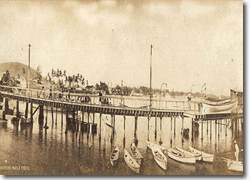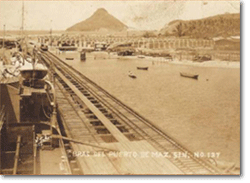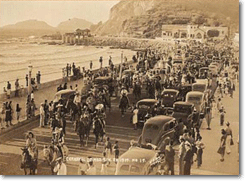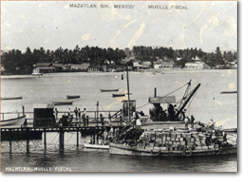History
Mazatlán comes etymologically from the nahuatl word "Mazatl" which means place of deer.
 First inhabitants of this region were nomadic tribes which settled in Mazatlán in order to get food by hunting deer and by fishing. In 1531 Don Nuño Beltrán de Guzmán conquered the region with his army and founded Northeast populations. Spaniards named the city Islas de Mazatlán, due to the three islands and hills in this area that were used as natural navigation reference for merchant ships. Francis Drake and Thomas Cavendish sailed our waters. At the beginning of the 18th. Century they used the port to send gold coins and other valuable products to Europe; these products were extracted in amazing amounts from Rosario and Mazatlán.Before the second half of the 19th. Century, Mazatlán became the most important commercial center of the west of Mexico, and took the place of Guaymas and San Blas due to its movement of import, export and distribution of merchandises through the port.Oldest statistics known shows that in 1826 three English ships, one French ship and one national ship arrived to Mazatlán, and in 1827 nine ships arrived: three English, three French, one Sardinian and two national (1) ships, which obviously motivated the Central Government to establish in 1823 a Maritime Customs House to charge the corresponding duties for foreign trade taking place in the port. In 1837 the first County Council was incorporated. Mazatlan was then the first port where European and American ships supplied their goods and made repairs. These ships traded with China at their return through the Sandwich Islands which helped to develop its movement.
First inhabitants of this region were nomadic tribes which settled in Mazatlán in order to get food by hunting deer and by fishing. In 1531 Don Nuño Beltrán de Guzmán conquered the region with his army and founded Northeast populations. Spaniards named the city Islas de Mazatlán, due to the three islands and hills in this area that were used as natural navigation reference for merchant ships. Francis Drake and Thomas Cavendish sailed our waters. At the beginning of the 18th. Century they used the port to send gold coins and other valuable products to Europe; these products were extracted in amazing amounts from Rosario and Mazatlán.Before the second half of the 19th. Century, Mazatlán became the most important commercial center of the west of Mexico, and took the place of Guaymas and San Blas due to its movement of import, export and distribution of merchandises through the port.Oldest statistics known shows that in 1826 three English ships, one French ship and one national ship arrived to Mazatlán, and in 1827 nine ships arrived: three English, three French, one Sardinian and two national (1) ships, which obviously motivated the Central Government to establish in 1823 a Maritime Customs House to charge the corresponding duties for foreign trade taking place in the port. In 1837 the first County Council was incorporated. Mazatlan was then the first port where European and American ships supplied their goods and made repairs. These ships traded with China at their return through the Sandwich Islands which helped to develop its movement. Gold discoveries in California in 1849 attracted a huge amount of immigrants to the territory recently acquired by Americans, causing a great demand for any kind of food and various products, virtually impossible to get in the USA region, scarcely developed back then. Various foreign nations fulfilled this demand, but mainly the Mexican zone of the Pacific due to its geographical proximity. This resulted in a very significant increase in the mercantile movement of the ports of Mazatlán, San Blás and Guaymas, but mainly in Mazatlán, from 1849 to 1853.Products sent to California via Mazatlán were basically food, clothes, textile and equipment for work animals, in significant volumes.The possibility of selling products both domestic and foreign, in California at considerable prices, as well as transporting passengers willing to make a fortune in auriferous pleasures, encouraged many shipowners to send their ships to San Francisco. Those ships transported from a few tons up to two hundred tons of products and merchandise which they sold at very good prices.
Gold discoveries in California in 1849 attracted a huge amount of immigrants to the territory recently acquired by Americans, causing a great demand for any kind of food and various products, virtually impossible to get in the USA region, scarcely developed back then. Various foreign nations fulfilled this demand, but mainly the Mexican zone of the Pacific due to its geographical proximity. This resulted in a very significant increase in the mercantile movement of the ports of Mazatlán, San Blás and Guaymas, but mainly in Mazatlán, from 1849 to 1853.Products sent to California via Mazatlán were basically food, clothes, textile and equipment for work animals, in significant volumes.The possibility of selling products both domestic and foreign, in California at considerable prices, as well as transporting passengers willing to make a fortune in auriferous pleasures, encouraged many shipowners to send their ships to San Francisco. Those ships transported from a few tons up to two hundred tons of products and merchandise which they sold at very good prices. The demand of gold merchandise and the growth of the American California caused Mazatlan to become the main port in the route towards and from San Francisco. According to the information kept in the U.S. Customs House Records of San Francisco, out of 436 ships that left Californian port towards Mexican ports between 1853 and 1875, 201 had Mazatlán as destination.Since the third and forth decades of the century, Europeans from different countries were interested in opening commercial establishments in Mazatlán in order to import products manufactured in their countries of origin, especially textiles, and to supply the important mining centers of the region: Rosario, Copala, Pánuco, Concordia, Cósala, Guadalupe de los Reyes and San Dimas. As a result, many commercial houses founded by foreigners and nationals were established in Mazatlán; some of them acquired importance throughout the years and transformed the port into the greatest maritime movement of the Mexican coast facing the Pacific ocean, the keeper and distributor of merchandises towards the interior coast of Mexico, currently the states of Nayarit, Jalisco, Colima, Durango, Sonora, Chihuahua and the Californias, and the center of a cabotage trade of the region that extended between San Francisco and Acapulco, and to Chiapas and Central America by the end of the century. Towards the third quarter of the century, many commercial companies were developed, most of them founded by foreigners, mainly German and Spaniards, but also some French and English, originally dedicated to the import trade. Throughout the years they had engaged successfully in banking, mining, industrial and agricultural activities that caused the development in every branch of the economic activity in Mazatlán by the end of the 19th. Century.Almost every one carried out wholesale and retail sales in a great variety of products, including basic commodities, imported goods, such as cheeses from Holland and France, butter from Denmark, olives, sausages, saffron, almonds, sardines, eel and Spanish olive oil, Italian pastas, wines and brandies from California, Bordeaux, Cognac, Champagne, Sherry, La Rioja, Catalonia and Port, beer from Germany, United States, Sonora, Chihuahua, Toluca and Monterrey, every kind of textiles, from domestic coarse cotton to jeans and silk, linens, muslin, cashmere and European and Oriental laces, stationary, chinaware and crystal of different origins, iron, steel, mining and agriculture equipment, arms, ammunitions and powder, English and American cement, and a great amount of luxury articles, such as jewelry, porcelain, perfumes, pictures, Vienna furniture, musical instruments, carpets and rugs.The movement of every kind of goods was mostly made in ships. At the beginning of the century at least six hundred ships arrived to the port each year, from big steamboats of more than seven thousand tons to small sailing boats of less than one hundred tons.Imports were basically paid with products from mines of the zone. In the fiscal year 1897-98, exports of precious metals through the port of Maztlán amounted to $4,329,300, and the currency exit abroad amounted to $849,541.
The demand of gold merchandise and the growth of the American California caused Mazatlan to become the main port in the route towards and from San Francisco. According to the information kept in the U.S. Customs House Records of San Francisco, out of 436 ships that left Californian port towards Mexican ports between 1853 and 1875, 201 had Mazatlán as destination.Since the third and forth decades of the century, Europeans from different countries were interested in opening commercial establishments in Mazatlán in order to import products manufactured in their countries of origin, especially textiles, and to supply the important mining centers of the region: Rosario, Copala, Pánuco, Concordia, Cósala, Guadalupe de los Reyes and San Dimas. As a result, many commercial houses founded by foreigners and nationals were established in Mazatlán; some of them acquired importance throughout the years and transformed the port into the greatest maritime movement of the Mexican coast facing the Pacific ocean, the keeper and distributor of merchandises towards the interior coast of Mexico, currently the states of Nayarit, Jalisco, Colima, Durango, Sonora, Chihuahua and the Californias, and the center of a cabotage trade of the region that extended between San Francisco and Acapulco, and to Chiapas and Central America by the end of the century. Towards the third quarter of the century, many commercial companies were developed, most of them founded by foreigners, mainly German and Spaniards, but also some French and English, originally dedicated to the import trade. Throughout the years they had engaged successfully in banking, mining, industrial and agricultural activities that caused the development in every branch of the economic activity in Mazatlán by the end of the 19th. Century.Almost every one carried out wholesale and retail sales in a great variety of products, including basic commodities, imported goods, such as cheeses from Holland and France, butter from Denmark, olives, sausages, saffron, almonds, sardines, eel and Spanish olive oil, Italian pastas, wines and brandies from California, Bordeaux, Cognac, Champagne, Sherry, La Rioja, Catalonia and Port, beer from Germany, United States, Sonora, Chihuahua, Toluca and Monterrey, every kind of textiles, from domestic coarse cotton to jeans and silk, linens, muslin, cashmere and European and Oriental laces, stationary, chinaware and crystal of different origins, iron, steel, mining and agriculture equipment, arms, ammunitions and powder, English and American cement, and a great amount of luxury articles, such as jewelry, porcelain, perfumes, pictures, Vienna furniture, musical instruments, carpets and rugs.The movement of every kind of goods was mostly made in ships. At the beginning of the century at least six hundred ships arrived to the port each year, from big steamboats of more than seven thousand tons to small sailing boats of less than one hundred tons.Imports were basically paid with products from mines of the zone. In the fiscal year 1897-98, exports of precious metals through the port of Maztlán amounted to $4,329,300, and the currency exit abroad amounted to $849,541. The companies La Compañía Minera de Panuco, Negociaciones Mineras de Guadalupe de los Reyes y La Piramide, Cervecería del Pacífico, Fundición de Sinaloa, Compañía Jabonera Unión, Fábrica de Hilados La Bahía and La Unión (cigarettes and cigars), La Universal (soap, oils and candles), La Concordia, El Roble sugar mill, Línea de Navegación del Pacífico, Transportes Marítimos and Naviera del Pacífico are only some of the companies that were born or developed from these big commercial houses.The great affluence of European people from various countries, American and Oriental people that established in Mazatlán, as well as the continuos arrival of foreign ships to the port, made the city one of the most cosmopolitan ones of the country, and its society one of the most sophisticated. High classes spent their summer holidays in San Francisco, and traveled frequently to Europe; their children studied in the United States, Germany, England or Spain. They met in the club La Unión or in El Casino, both surrounding the Machado Square, and they attended to the shows at Rubio Theater, the most elegant and sophisticated of the city.
The companies La Compañía Minera de Panuco, Negociaciones Mineras de Guadalupe de los Reyes y La Piramide, Cervecería del Pacífico, Fundición de Sinaloa, Compañía Jabonera Unión, Fábrica de Hilados La Bahía and La Unión (cigarettes and cigars), La Universal (soap, oils and candles), La Concordia, El Roble sugar mill, Línea de Navegación del Pacífico, Transportes Marítimos and Naviera del Pacífico are only some of the companies that were born or developed from these big commercial houses.The great affluence of European people from various countries, American and Oriental people that established in Mazatlán, as well as the continuos arrival of foreign ships to the port, made the city one of the most cosmopolitan ones of the country, and its society one of the most sophisticated. High classes spent their summer holidays in San Francisco, and traveled frequently to Europe; their children studied in the United States, Germany, England or Spain. They met in the club La Unión or in El Casino, both surrounding the Machado Square, and they attended to the shows at Rubio Theater, the most elegant and sophisticated of the city.
"The economic importance of Mazatlán made it the main city in the northeast of Mexico as of the decade of 1860.
| Last Modification: | 27/08/2010 (15:00 Hours) | Produced by Quality department |
| Last Review Content: | Review by Head of Quality Management |